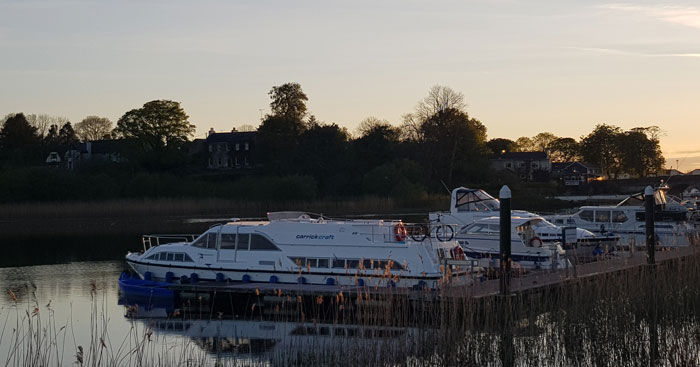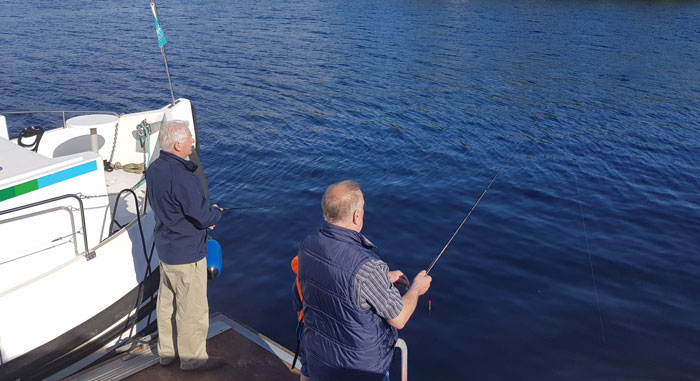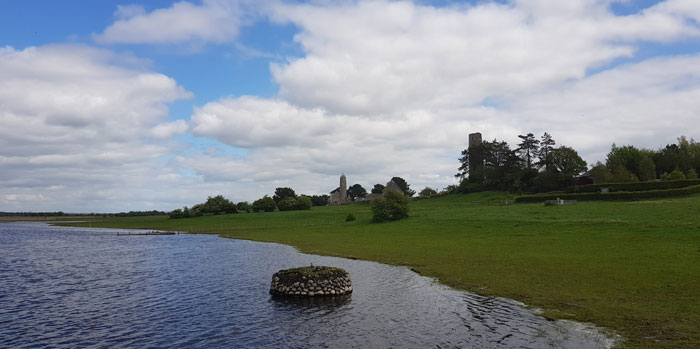Where is Lough Erne?
Lough Erne is the name of two connecting lakes in Northern Ireland’s Irish County Fermanagh. It’s the second biggest lake system in Northern Ireland and Ulster and the fourth largest in the entirety of Ireland.
The whole lake system is a widening of the River Erne and is made up of two separate lakes, connected by a narrowing of the river. The two Lough Erne waterways are made up of a smaller southern lake, called the Upper Lough, as it is higher up the river and the bigger northern lake, called the Lower Lough or Broad Lough.
Although residing in Northern Ireland, part of the United Kingdom, Lough Erne is connected to the Shannon, Ireland’s most famous and coveted river, by the Shannon-Erne Waterway. This man-made canal connects the two waterways, making for one of the most epic and rewarding canal boat holidays in western Europe.
With a chance to begin or end in Lough Erne and the whole Shannon waterway in front or behind you, the chances for rewarding Lough Erne cruises are limitless. With a soft border still intact between Ireland and Northern Ireland, boating this stretch of waterway is one that offers a myriad of sights and landmarks that only add to a rewarding journey.
How do you get to Lough Erne?
You can start your Lough Erne boat trip from a number of different places across Ireland, all depending on what you want to get out of your trip.
Begin your adventure from Carrick-on-Shannon

Though 50 miles south of Lough Erne , one of the most popular places to begin your boat journey to the lough is from the town of Carrick-on-Shannon. With Locaboat based here, you can hire a well-maintain boat in no time at all.
Alongside this, the Carrick-on-Shannon to Lough Erne route is one of the most interesting stretches of waterways on the island. The route offers boaters the chance to travel along the most famous Irish river, complete with many must-see sights along the way. These sights can be such simple things as historic landmarks and natural wonders or more in-depth attractions such as quaint towns and villages along the way north.
Taking this route you can also travel from one country to another. Starting out in the Republic of Ireland, your boating trip will wander north through the Irish county of County Caven via the Erne-Shannon waterway and cross into Northern Ireland.
Starting from Lough Erne itself
It’s also possible to begin your Lough Erne adventure from the lough itself. Lough Erne boat hire is made possible by the popularity of the lake and means you can enjoy all that it has to offer right off the back.
After exploring both lower and upper Lough Erne, you can then choose whether to travel south and soak up all the best of the River Shannon after. There is no right or wrong route when travelling through Ireland and Northern Ireland’s waterways, and with such easy access and a multitude of routes, the choices are endless.
Top 6 things to do near Lough Erne
1. Explore the fascinating town of Enniskillen
The town of Enniskillen sits directly between Upper and Lower Lough Erne and is the fulcrum on which all travel in this area depends. As one of the largest towns in the area, Enniskillen is an unmissable stopping off point when travelling through Lough Erne in Northern Ireland .
For the history buffs amongst us visiting this area of Ireland, the nearby Enniskillen Castle is a must-see. Built in the early 15th century, the castle was very quickly used as troop barracks, a feature that lasted right into the 20th century. The castle is divided into two sections, a central keep and a large curtained wall adorned with turrets. Enniskillen Castle is also the location of the Fermanagh County Museum, a museum dedicated to the history of the area, from prehistory right up to the modern day.
2. Take to the waters by canoe or kayak
Though you will be boating across the water in your home away from home, you may wish to get a little closer to the surface and experience a more adventurous side to the lake. The best way to do this is to hire a canoe or kayak.
The rugged coastline of Lough Erne and its sheer size means that large waves can build during windy periods, providing an ideal environment for the experienced canoeist.
Unlike your Lough Erne cruiser hire , a kayak or canoe gives you the ability to get close to over 150 islands, inlets and coves that are scattered around the lough. These islands and inlets are ideally placed to be explored via a small vessel such as a kayak or canoe – only adding to the adventurous nature of Lough Erne activities .
3. Try your hand at fishing on Lough Erne

One of Lough Erne’s most attractive aspects is the fantastic angling opportunities it provides. Much like the wider reaches of County Fermanagh, the expansive waters of the lough, its many inlets and coves all provide the perfect environment for fishing.
So good is the coarse fishing around Lough Erne that it has become a premier location for professional fishing competitions and competitors from all over Europe.
Keen fishermen and women can set their best fishing skills on the lake, catching a range of different fish species. The most common of these are the common roach, which can be caught here in their thousands. Aside from these, there is also a huge population of wild brown trout, bream, pike and a number of salmon.
4. Hire a bike and explore Lough Erne by land
One of the most popular Lough Erne activities is arguably one of the most simple to enjoy. The hiking and walking trails that criss-cross the area surrounding Lough Erne are some of the most rewarding and picturesque throughout Northern Ireland.
It’s easy enough to moar up your boat in one of the Lough Erne marinas and set off on a walk through woodlands and rolling hills that surround the lake.
If you’re more comfortable on two wheels, fear not! Lough Erne is also a great place for exploring by bike. The region itself is part of the wider County Fermanagh National Cycle Network, meaning there are many signed cycle ways crisscrossing the area. These range from traffic-free and family-friendly routes to more in-depth and testing cycling routes around Lough Erne .
5. Discover the Marble Arch Caves
Only a short distance from the lakes of Lough Erne is one of the best show caves in Europe, a great expanse of limestone caves hidden under the earth. These limestone caves were first explored in the 18th century. However, it wasn’t until the 1980s that work began to make the caves accessible for visitors.
Today, you can explore the caves thanks to the additions of concrete floorings, handrails and steps leading down into the deepest regions. After exploring the Marble Arch Caves, you can then come to the surface and pop into the visitor centre which showcases the long and interesting history of the caves.
One of the most popular show caves anywhere in Europe, a visit to Marble Arch Caves is not to be missed when on your Lough Erne boat holiday .
Get up close and personal with wildlife on Lough Erne
Aside from the long list of recreational activities, both upper and lower Lough Erne provide the perfect environments for a plethora of wildlife to thrive and the chance for you to view them in their natural habitats.
The region around the upper lake and the borders of the UK and Ireland are some of the best places to see wildlife on the island and for animal lovers, boating through Lough Erne and its inlets allows you to catch sight of so much of this wildlife.
One of the best places to do this is the National Trust conservation area above Upper Lough Erne. This reserve is a home for an array of birdlife, including wading birds such as curlew, lapwing, common redshank, and even the protected snipe.
The mature oak woodlands that surround the waterways are also home to some of the rarest butterflies found anywhere in the UK. Keen-eyed butterfly spotters may be in luck and catch sight of butterflies such as the silver-washed fritillary and the garden tiger moth.
It’s not only the huge range of insects and birds you can see in the land surrounding Lough Erne; there are also a number of rarely seen mammals. The rarer red squirrel can sometimes be seen climbing the oaks around the lake, a sight that is unusual in northwest Europe after the introduction of the grey. One main reason why red squirrels are on the recovery here is thanks to another animal, the pine marten.
Top of the list for animal lovers and wildlife spotters travelling through the Lough Erne and the rivers surrounding it has to be the large family of otters here. Often seen searching for food and patrolling their territories, otters are a highlight of any nature visit to this area of Northern Ireland.
Must-see sights as you travel to Lough Erne
Whether you’re beginning your boating holiday at Lough Erne or further south along the River Shannon, planning your route and deciding which way to go is important. Not only will it allow you to organise your route far better, but it also ensures you don’t miss the numerous landmarks and attractions on the way.
Starting your journey from Carrick-on-Shannon

Many boating holidays through Ireland and Northern Ireland will begin in the town of Carrick-on-Shannon. This is not only a great practical place to secure your Shannon boat hire but is a place of interest all by itself. A town full of history and culture, one of Carrick-on-Shannon’s most interesting landmarks is its Costello Chapel. Built as the resting place of one Edward and Mary Costello, local traders in the area, Costello Chapel is one of the smallest chapels in the entire world.
Carrick-on-Shannon’s former 19th-century courthouse has been restored to become Leitrim’s first integrated centre for the arts, a centre known as The Dock. The Dock holds a 100 seater performance space, three art galleries and an artists studio. Timing your arrival and boat departure right, you may even be able to catch an event at The Dock while you are here.
Heading north and through the Shannon–Erne Waterway
After leaving Carrick-on-Shannon, you and your boat will make its way north, passing along the River Shannon. This section of the river is home to some of the most idyllic and charming landscapes that the River Shannon has to offer, and you will quickly realise why travelling to Lough Erne, Ireland via this particular route is so popular.
Moving away from the natural watercourse of the River Shannon, you will then make your way easterly along the Shannon-Erne Waterway, a man-made canal that connects the Irish river of Shannon to the Northern Irish river of Erne. As soon as you enter the canal, you shall arrive at the small settlement of Leitrim Village.
Leitrim Village is an ideal place to stop off before making your way down the canal, offering up a number of great landmarks and attractions, as well as being a charming and idyllic Irish village in its own right, something that truly makes a trip like this. One of the biggest draws, aside from the picturesque nature of the village, is the castle ruins of O’Rourke’s Castle.
First constructed in the late 15th century, the castle is undoubtedly a tower house built at the request of one Sir Brian O’Rourke. The castle was besieged and destroyed in the late 16th century and has remained in ruins since. Exploring the remains of O’Rourke’s Castle takes you down through the centuries of medieval Ireland and the stories it has to tell.
Travelling through the Shannon-Erne Waterway to is eastern end, you will soon come to the easterly town of Ballinamore, another of the charming settlements along the canal. The rural town centre of the area, Ballinamore, is a great place to see how charming Irish rural life goes after all these years. Top attractions in the town include the Old Court House, built in the 1830s and the Church of Ireland, built around 1780. The 19th century arched stone bridges in the town also offer a glimpse into this town’s overwhelming charm.
Continuing through Belturbet and crossing the Ireland/UK border
Exiting the Shannon–Erne Waterway, you will quickly join the River Erne and wind your way past the town of Belturbet. Belturbet is one of the most attractive historic towns on the River Erne and the centre of the region’s new heritage tourism project. Aside from the obvious township beauty that comes with many small towns and villages around this area of Ireland, Belturbet is also a great place to visit for its historical landmarks.
The best of these is the GNR Cut stone railway station that was built in 1885. This has now been restored to its former glory and houses an in-depth exhibition telling the history of the station and its place with the local community. For real fans of railway history, the station also has a huge collection of railway memorabilia from the past centuries.
After leaving the town, your journey will take you further up the River Erne, finally passing the soft border, leaving the Republic of Ireland and passing into Northern Ireland. One of the first landmarks and attractions you will first come to is the Crom Estate, run by the natural trust. Looming large over the estate is Crom Castle, first constructed by a Scottish planter at the beginning of the 17th century. This stunning building dominates the two-thousand-acre estate and is an awe-inspiring welcome once you cross the Northern Irish border.





















